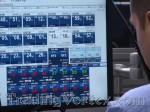Table Of Contents:
- Understanding Swing Trading:
Should a beginner do swing trading?
Common Strategies and Tools for Swing Trading:
Risk Management Strategies in Swing Trading
Getting Started as a Swing Trader:
Conclusion: The Evolving Landscape of Swing Trading.
Understanding Swing Trading:
Central to swing trading is the conviction that financial markets pulsate in discernible waves or swings, presenting windows of opportunity for astute traders. These traders hold positions not just for a single trading session, as in day trading, but typically for a period spanning several days to weeks. While this duration is a guiding principle, the exact length of trades hinges on market conditions and the trader's preference.
Unlike conventional investors who focus on an asset's long-term trajectory, swing traders prioritize capturing segments of price movements. This endeavor is powered by an arsenal of technical analysis tools, including chart patterns, trend lines, support and resistance levels, and indicators, which inform entry and exit decisions. Augmenting this approach, fundamental analysis can supplement insights through factors such as earnings reports, news releases, economic data, and analyst opinions. Additionally, market sentiment indicators such as volume, volatility, and social media trends contribute valuable insights into market participants' behavior and attitudes.
Swing trading's adaptability renders it applicable to diverse markets, spanning stocks, Forex, commodities, cryptocurrencies, and options. However, the suitability varies based on factors such as liquidity and volatility. Liquidity gauges an asset's ease of trading without perturbing its price, while volatility encapsulates price oscillations over time. Swing traders gravitate towards markets characterized by high liquidity and substantial volatility, as these facets enhance opportunities for profitable moves.
Advantages and Disadvantages of Swing Trading:
An exploration of swing trading's merits and limitations highlights its distinct features:
Advantages:
- Amplified Profit Potential: The focus on larger price movements over a slightly longer horizon lends swing trading the potential for more substantial per-trade profits compared to shorter-term strategies.
- Mitigated Stress and Time Commitment: In contrast to day traders perpetually monitoring markets, swing traders experience less strain and time constraints, as constant vigilance isn't required. This also mitigates the risk tied to overnight and weekend market gaps.
- Adaptability and Flexibility: Unlike trend trading or long-term investing, swing trading empowers traders to pivot across markets, instruments, time frames, and strategies to align with evolving market conditions.
- Intellectual Engagement: Swing trading rewards traders' analytical prowess and creative acumen, making it a captivating endeavor.
Disadvantages:
- Amplified Risk Exposure: The extended holding period amplifies swing traders' exposure to market fluctuations, necessitating adept risk management strategies to contend with heightened uncertainty.
- Complexity and Learning Curve: As the strategy incorporates multiple analysis techniques, tools, and factors influencing market dynamics, mastery demands a steep learning curve.
- Emotional Challenges: The dynamic nature of swing trading requires rapid adaptation to shifting market currents, inevitably contributing to emotional stress and psychological pressures.
Should a beginner do swing trading?
Swing trading can be an attractive option for beginners who want to learn how to trade the financial markets and make profits from price movements. However, swing trading also involves certain challenges and risks that beginners should be aware of and prepared for. Here are some of the pros and cons of swing trading for beginners:
Pros
- Swing trading can offer higher profits per trade than day trading or scalping, as swing traders aim for larger price moves over a longer time frame. This can also reduce the impact of commissions and fees on the overall returns.
- Swing trading can be less stressful and time-consuming than day trading or scalping, as swing traders do not have to monitor the market constantly and make quick decisions. They can also avoid overnight and weekend risks, where the price could gap and open at a substantially different level the following session.
- Swing trading can be more flexible and adaptable than trend trading or buy-and-hold investing, as swing traders can switch between different markets, instruments, time frames, and strategies depending on the market conditions and their personal goals. They can also take advantage of various opportunities and scenarios in the market.
- Swing trading can be more rewarding and satisfying than other trading styles, as swing traders can apply their creativity and analytical skills to find and execute profitable trades. They can also learn from their mistakes and improve their trading skills and confidence.
Cons
- Swing trading can involve higher risks and losses than day trading or scalping, as swing traders expose themselves to more market fluctuations and uncertainties over a longer time frame. They also have to deal with emotional stress and psychological pressure that come with managing their trades.
- Swing trading can be more challenging and complex than trend trading or buy-and-hold investing, as swing traders have to deal with more factors and variables that affect the market movements. They also have to master multiple forms of analysis and tools to identify and execute their trades.
- Swing trading can be more demanding and frustrating than other trading styles, as swing traders have to cope with frequent market changes and adjustments. They also have to follow strict rules and guidelines, such as position sizing, stop-loss orders, diversification, and risk management, to ensure their trading success.
Swing trading can be a great way for beginners to learn how to trade the financial markets and make profits from price movements. However, it also requires a lot of dedication, discipline, patience, and learning. By mastering swing trading, beginners can enhance their confidence and competence in trading, and achieve their trading goals and dreams.
Common Strategies and Tools for Swing Trading:
Swing traders leverage a repertoire of strategies and tools to effectively unearth and execute profitable trades:
Swing Trading Strategies:
- Trend Following: This strategy involves tracking dominant market trends, entering trades during price retracements, and exiting as signs of trend reversal materialize.
- Breakout: Swing traders adopt this approach when an asset's price breaches consolidation patterns or significant support/resistance levels, indicating potential substantial moves.
- Reversal: Leveraging this strategy, traders identify assets' directional reversals following prior trends, relying on indicators and candlestick patterns for precise entry and exit points.
Swing Trading Tools:
- Charting Software: This software empowers traders to visualize and scrutinize price movements using diverse chart types, accompanied by an array of technical analysis tools.
- Trading Platform: By facilitating order execution, access to market data, news feeds, and even automation, trading platforms streamline the trading process.
- Trading Journal: This record-keeping tool captures trading activities, enabling performance tracking, strengths/weaknesses assessment, and skill refinement over time.
Risk Management Strategies in Swing Trading
Risk management is a cornerstone of successful swing trading. It refers to the process of identifying, measuring, and controlling the potential losses that may arise from trading activities. Risk management helps swing traders to safeguard their capital, minimize their drawdowns, and maximize their returns. It also helps swing traders to cope with the emotional and psychological aspects of trading, such as fear, greed, stress, and overconfidence.
There are various risk management techniques that swing traders can employ to navigate the volatile nature of markets. Some of the most common ones are:
- Position sizing: This is the technique of determining how much money to invest in each trade, based on the risk level and the expected return. Position sizing helps swing traders to balance their risk and reward, and to avoid risking too much or too little on any single trade. A common method of position sizing is to use a fixed percentage of the total trading capital, such as 1% or 2%, for each trade. Another method is to use the Kelly criterion, which is a formula that calculates the optimal position size based on the probability of winning and the payoff ratio.
- Stop-loss orders: These are orders that automatically close a trade when the price reaches a predetermined level, usually below the entry price for a long position or above the entry price for a short position. Stop-loss orders help swing traders to limit their losses and protect their profits, and to avoid holding on to losing trades for too long. A common method of setting stop-loss orders is to use a fixed amount of money or a percentage of the entry price, such as $100 or 5%, for each trade. Another method is to use technical analysis, such as support and resistance levels, trend lines, or indicators, to determine the exit point based on the price action.
- Diversification: This is the technique of spreading the trading capital across different markets, instruments, time frames, and strategies, to reduce the exposure to any single source of risk. Diversification helps swing traders to reduce their overall portfolio risk, and to take advantage of various opportunities and scenarios in the market. A common method of diversification is to use a portfolio allocation model, such as the Modern Portfolio Theory or the Capital Asset Pricing Model, which optimizes the portfolio based on the expected return and risk of each asset class.
- Managing overall portfolio risk: This is the technique of monitoring and adjusting the total amount of risk that the swing trader is willing to take on at any given time, based on the market conditions and the trader's goals. Managing overall portfolio risk helps swing traders to align their risk appetite with their trading objectives, and to adapt their trading style accordingly. A common method of managing overall portfolio risk is to use a risk management system, such as the Value at Risk or the Expected Shortfall, which measures the maximum potential loss or shortfall that the portfolio may incur over a certain period of time.
These are some of the risk management strategies that swing traders can use to improve their trading performance and results. However, these strategies are not foolproof or guaranteed, and they require constant evaluation and refinement. Therefore, swing traders should always follow their own rules and guidelines, and be aware of their own strengths and weaknesses, when applying these strategies.
Psychology and Emotional Discipline in Swing Trading:
While swing trading is built on the foundation of technical analysis and market research, the human element of trading psychology plays a pivotal role in determining success. The ability to manage emotions, maintain discipline, and make rational decisions under pressure is what sets apart consistently profitable swing traders from those who struggle to navigate the turbulent waters of the financial markets.
The Psychological Challenges of Swing Trading:
Emotions like fear, greed, and anxiety are inherent to trading. Swing traders often experience these emotions as they witness their trades fluctuate in value. Understanding and acknowledging these emotional responses is the first step towards mastering the psychological aspect of swing trading.
Dealing with Losses:
Losses are an inevitable part of trading, but they can be particularly challenging for swing traders who might hold positions for several days or weeks. Accepting losses as a natural part of the trading process and reframing them as learning opportunities can help mitigate their psychological impact. It's important to avoid chasing losses or seeking revenge trades, as these actions can lead to impulsive decisions and further losses.
Overcoming Greed:
Greed can be just as detrimental as fear. When swing traders see profits accumulating, there might be a temptation to hold onto a winning position for longer than planned, hoping for even greater gains. This can lead to missing out on the optimal exit point and turning a winning trade into a losing one. Setting clear profit targets and adhering to them can help mitigate the influence of greed.
Maintaining Emotional Resilience:
The ability to remain emotionally resilient in the face of market fluctuations is a hallmark of successful swing traders. This resilience comes from having confidence in one's trading strategy and maintaining a long-term perspective. Developing a routine that includes mindfulness, exercise, and activities outside of trading can also contribute to emotional well-being.
The Role of Discipline and Consistency:
Discipline is the bedrock of successful swing trading. Having a well-defined trading plan, including entry and exit criteria, risk management strategies, and a clear set of rules, helps traders stay focused and prevent emotional decision-making. Consistently adhering to the trading plan, even in the face of uncertainty or unexpected events, is crucial to maintaining a structured approach to trading.
Managing Information Overload:
In today's fast-paced world, traders are bombarded with an overwhelming amount of information from news, social media, and market analysis. This constant influx of information can lead to analysis paralysis and emotional overload. Developing the ability to filter out noise, focus on relevant information, and trust one's own analysis can help swing traders make informed decisions without being swayed by market sentiment.
Developing a Trading Mindset:
Cultivating a trading mindset takes time and practice. This involves understanding that losses are part of the journey, focusing on process over outcome, and maintaining a long-term perspective. It also entails being patient and not succumbing to the pressure of making trades for the sake of staying active in the market. Visualization techniques, positive self-talk, and continuous learning can contribute to the development of a resilient and disciplined trading mindset.
Mastering the Mental Game:
While technical analysis and market research are vital components of successful swing trading, the psychological aspect is equally important. Developing emotional discipline, resilience, and a trading mindset are essential for navigating the highs and lows of the market. Recognizing and managing emotions, adhering to a well-defined trading plan, and maintaining consistency in decision-making can position swing traders for long-term success. Just as markets evolve, so too must a trader's psychological approach evolve, enabling them to thrive in the ever-changing landscape of swing trading.
Getting Started as a Swing Trader:
Embarking on the swing trading journey involves a systematic approach:
- Learn the Basics: Gather foundational knowledge by immersing yourself in books, articles, blogs, podcasts, videos, online courses, and forums dedicated to swing trading.
- Choose Your Arena: Select markets and instruments aligning with your risk appetite, personality, goals, and preferences, while avoiding over-diversification.
- Forge Your Strategy: Craft a comprehensive trading strategy with well-defined entry/exit criteria, risk management protocols, performance metrics, and a trading schedule.
- Hone Your Skills: Refine your skills through demo or paper trading accounts, which offer simulated environments for testing strategies sans actual risk.
- Enter the Live Arena: Initiate your journey by opening a live account with a reputable broker catering to your chosen market and instrument, all the while starting with a manageable capital amount.
- Stick to the Script: Implement your strategy consistently, monitor progress, adapt to shifting market tides, and consistently refine your approach.
Conclusion: The Evolving Landscape of Swing Trading.
In the dynamic world of finance, swing trading stands as a compelling gateway to capitalizing on short- to medium-term market movements. Armed with a diverse toolkit of technical and fundamental analysis, swing traders navigate a realm where calculated decisions are forged amidst volatile shifts. This article has delved into the multifaceted realm of swing trading, encompassing its core principles, advantages, challenges, strategic paradigms, tools, and the psychological fortitude required for success.
A Glimpse Into the Future:
As financial markets continue to evolve, so does the landscape of swing trading. Technological advancements, data accessibility, and algorithmic trading are reshaping how swing traders operate. Automation tools, advanced charting software, and machine learning algorithms empower traders to extract insights and execute trades with greater precision. The integration of artificial intelligence and big data analytics further refines market analysis, providing traders with a deeper understanding of market dynamics.
Navigating Regulatory Changes:
The regulatory environment is another aspect of the evolving landscape. Swing traders must remain vigilant about changes in trading regulations and compliance requirements. Adapting to these shifts ensures traders can navigate markets while adhering to legal and ethical standards, safeguarding both their interests and the integrity of the financial ecosystem.
The Role of Education and Community:
Education remains a bedrock of success in swing trading. Continuous learning, staying updated on market trends, and honing trading skills are essential for staying ahead. The online trading community, enriched with forums, webinars, and social platforms, offers a space for interaction, knowledge sharing, and idea exchange among traders. Collaborative learning and mentorship within these communities contribute to a holistic understanding of swing trading's ever-changing intricacies.
Final Words of Wisdom:
As you embark on your journey as a swing trader, remember that mastery is not achieved overnight. Success in swing trading requires a blend of analytical prowess, emotional discipline, and strategic acumen. The journey is marked by ups and downs, learning from both wins and losses. Stay adaptable, be open to new ideas, and continuously refine your approach.
In the end, swing trading is a dynamic dance with the markets, an art that merges analysis and intuition, and a science that fuses strategy with psychology. By mastering the intricacies of swing trading, you join a community of traders who have honed their skills to navigate the ever-evolving landscape of financial markets. As you embrace the challenges and rewards, remember that the pursuit of mastery is a journey with no final destination,rather a continuous evolution toward excellence in the pursuit of profitable trading.









































 TradingVortex.com® 2019 © All Rights Reserved.
TradingVortex.com® 2019 © All Rights Reserved.